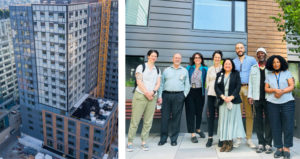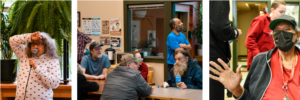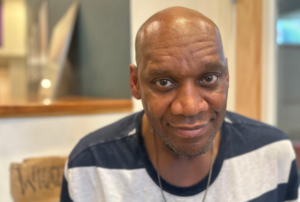
Obtaining a safe, permanent home is only one step in a journey toward leaving homelessness. When people feel a sense of emotional and mental well-being—that’s when they’re able to leave homelessness behind forever.
That’s why a strategy to end homelessness isn’t complete without behavioral health care. Though most people associate behavioral health care only with the treatment of mental illness and substance use disorders, Plymouth is taking proactive steps to address resident well-being needs because as the Full Frame Initiative states, equitable access to well-being is the pathway to health—including behavioral health.
Huynh Chhor (pronounced like “win chore”), VP & Chief of Behavioral Health Care Integration, leads this vital work at Plymouth. Chhor previously held roles at Swedish Edmonds such as Outpatient Behavioral Health Manager, Clinical Social Work Supervisor—and most recently—Director of Operations for Swedish Medical Group. Long ago, she served on the mobile crisis team with DESC.
“Behavioral health care needs to see people for the fullness of their humanity and looks at their needs holistically,” Chhor says. “This approach recognizes that people may benefit from an activity like gardening—getting to care for and nurture life; plants and flowers. Healing takes place through relationships, with pets or neighbors, at ethnic or cultural celebrations, or through singing or dancing.”
These activities are not simply extracurricular. Combined with medical care, counseling and more, these activities can play a vital role in helping someone find stability after homelessness. In the Q&A below, Chhor shares more about what drives her in this work and the role behavioral health care plays in addressing the homelessness crisis.
Q: Why does well-being play such a critical role in helping people leave homelessness behind permanently?
HC: Housing is the first step to stability—to give people the opportunity to thrive beyond survival mode. For our residents, a big barrier to achieving health is the lack of equitable access to the five domains of well-being: safety, stability, mastery, social connectedness, and access to meaningful resources as described by the Full Frame Initiative.
Our residents sometimes have to make tradeoffs in one or more domains of well-being to access care that they assess are too high or “not worth it.” For example, a person who is unhoused may use methamphetamine to stay awake at night because they’re scared of being assaulted or having their most precious possessions stolen.
What people may not immediately see about this person’s use of methamphetamine is that it is a response to getting their well-being need of safety met in the absence of physical security and housing. Sacrificing safety is too high a tradeoff to quit using. This is just one example of the many calculations our unhoused members of the community are faced with everyday and it continues even after they become housed, so as clinicians, we must support opportunities for residents to achieve their well-being needs as we think about how to provide holistic, whole-person integrated behavioral health services.
When people start getting more well-being needs met, it’s easier for them to engage in other services that can support them. We know that we will need to deliver care using an integrated approach; people are whole beings—our care model needs to reflect their preferences and unique needs.
Q: Tell me more about Plymouth’s approach to behavioral health care—including any plans for growth.
We function as one interdisciplinary care team for our residents; we progress care in a collaborative and seamless manner, with the resident at the center of all aspects of their care. Our goal will be to provide stay-based services, which will hopefully eliminate some of the structural barriers to care, which we will do by building our own internal capacity to deliver services and through strategic partnerships with external provider groups, healthcare systems, and social service agencies. Our internal model will comprise both on-site services and a hybrid mobile care team that can be deployed to buildings on a rotating or as-needed basis. If residents at another building need to access services on a day that the mobile clinic is not at their site, their case managers can accompany them to the housing site where it is taking place for that day. The key thing is that we’re not siloing care and teams but integrating services and people at every level of the organization. Ultimately, this will help us reduce operational costs and inefficiencies, while delivering better care. It’s a win-win.
In addition to ensuring access to a continuum of services and care, we also want to develop a continuum of housing types, because one supportive housing model will not fit every resident. As we expand our types of supportive housing portfolio, we will examine how we can integrate trauma-informed design as a “first line of therapy,” like the architects did for Laurel House, a supportive housing project in Grand Junction, Colorado.
Q: What’s an example of “co-creating conditions for thriving”?
For example, if someone is in a wheelchair and doesn’t have the right mobility resources–that could impact their ability to go to community events so they may feel very lonely. They may feel isolated from their peers.
One of the domains of well-being is access to meaningful resources, which Plymouth staff address by ensuring people have the tangible items they need to thrive in housing. For example, someone using a wheelchair may not have the right resources to easily navigate their room or the building, which could impact their ability to attend community events or engage with their case managers, leaving them feeling isolated and alone. Getting the resident resources they need to function well in their environment so they do not have to trade opportunities for social connections is another way we can move people onto the path of health and well-being.

Healing through relationships–including pets: August, a Plymouth resident, is healing from the trauma of homelessness in a recovery-based building where she also receives treatment for epilepsy. Here in her home, she enjoys time with her bestie Pika the cockatiel, plus studying for her Seattle Central College classes.
Q: From your perspective, what do people consistently get wrong about substance use and/or mental health?
HC: There’s a misconception that people engaging in the use of substances don’t want to or can’t change their use or improve their lives, especially without a “tough love” approach to care. (We use the non-stigmatizing term “substance use disorder” rather than “drug or alcohol addiction” in keeping with best practices in the field).
I was attending an intensive tobacco cessation training and remember learning that 40 percent of people want to quit and as high as 80 or 90 percent of people are willing to engage in treatment, but accessing care that’s culturally relevant, non-judgmental, affordable, convenient and trauma-informed was too hard. Additionally, the timing and the place at which services are available can present a barrier. Internal motivation for change can fluctuate greatly, so when someone is ready to seek out care, that care needs to be readily available, but this is not often the case, especially for our residents, but it can be transformative when someone is able to access the care they need, in the way they want it, at the right time.
I saw many examples of this when I was working at Swedish Edmonds. After developing the first-ever MOUD (Medications for Opioid Use Disorder) program in the hospital, I started hearing stories about life altering changes people were able to make in their lives as a result of one Emergency Department visit (where services are available 24/7 and our medication assisted therapy (MAT) partner being available next business day for follow-up care). Stories, such as a mom maintaining custody of her child and her employment so she could pay for her car and go back to school. People can be very successful addressing their substance use, but we need to have a nuanced perspective on what “success” means for someone. Not everyone will quit using substances altogether, but they can take steps to use safer or to reduce the negative consequences of substance to live a life closer to what they envision for themselves.
Q: Plymouth is dedicated to ending homelessness and addressing its causes. Why does behavioral health play such an important role in the solution?
HC: Homelessness and behavioral health are connected—the research shows this.
If someone has a mental health or substance use condition, their homelessness makes it more difficult to access services and to experience the conditions of well-being that makes it possible to achieve health, and to shift their physiological state out of survival mode. For some of our residents and others who have experienced homelessness, untreated mental health and/or substance use may have contributed to the conditions for which they became unhoused. Again, the causes of homelessness are complex and wide, so we’ll need to tackle the issue from multiple angles. Addressing behavioral health needs is vital to helping people stay housed and reach a more optimal level of well-being. Additionally, addressing needs more proactively—away from the most acute settings of our health systems—will alleviate the strain on our hospitals and crisis systems. The work we do is going to help alleviate pain points across the continuum of care.
People who experience homelessness are more likely to experience substance use disorders. Having a behavioral care condition may help cause someone’s homelessness—and that could lead them to develop behavioral-health needs. According to the U.S. Urban Development, among people experiencing homelessness on any given night, 20 percent had a serious mental health illness or condition and 17 percent had a chronic substance use or disorder comorbidities. Addressing behavioral health needs is vital to helping people stay housed and reach a level of well-being. Increasing our behavioral health care will help our communities and will prevent our health care systems from becoming overwhelmed.

Behavioral health care at Blake House: In Plymouth’s newest building on First Hill (pictured left), residents have a variety of tools and resources to help them improve their lives and move toward greater well-being. Through a partnership with Swedish, residents are able to receive on-site health care–including access to behavioral health care in their residency clinic across the street. Pictured right: the Swedish Residency leadership team visiting with Blake House staff.
Q: In a time where many in the Pacific Northwest have such fatigue for the homelessness crisis, what keeps you energized in this work?
HC: Our staff at the frontlines. The people doing this work. I feel inspired that they keep showing up for their residents and their community—and that inspires me to keep going. I feel honored to do this work alongside our caregivers and ease their way as they do the hard work. It’s not an easy job.
Q: What drew you to this field in the first place? Did you think you were going to be a social worker when you were a kid?
HC: I remember being in my room when I was 12 years old, thinking about what I wanted to be when I grew up. I imagined myself doing some international humanitarian work, maybe through an organization like Doctors Without Borders. I just knew I wanted to help the people who needed help the most. Fast forward many years, I’m in my junior or senior year of college, at a critical point of needing to decide what I wanted to do after undergrad. I was a neurobiology major so had a couple of options in front of me, neither felt entirely right.
My “ah-ha” moment came during a chance elective health services class I was taking where I learned about health care disparities, specifically around the higher infant and maternal mortality rates experienced by Black women. In that moment, I realized there were many ways to help people beyond the options I had given myself. As I learned more about social work and in reading the code of ethics, I realized the profession was very aligned with my personal values and mission. The work felt like more than a “job,”—it felt like a calling. So I applied to social work school. In some ways, I think I’ve always been a social worker, so this work feels very intuitive for me. I didn’t know I wanted to work in behavioral health until I started working on the mobile crisis team at DESC after moving back from Michigan. It felt like home and it was a life changing work experience for me. Working at Plymouth very much feels like a return home.

The healing power of community: Each month, residents at the Plymouth Place Apartments gather in the community room for an open mic night: an evening filled with song, poetry, laughter, and community. Community itself is a key ingredient in a person’s well-being, their emotional and mental health. Site Director Brandon Getz helps to make these events possible by encouraging residents to come down to watch their peers perform while enjoying dinner.
Q: Can you describe a pivotal moment in your career that you will never forget? Why did that make an impact on you?
HC: I remember this like it was yesterday. I was working on the mobile crisis team, outreaching a man who had been living under a bridge for many years. The police called us to outreach this client because the city recently passed a city ordinance that made living outside illegal, so he had to leave. But they didn’t know where to send him and wanted him to get some help.
The client was a veteran who had served in combat. He was likely experiencing psychosis—and he was not connected to services. This person was incredibly resourceful and had built a fortress for himself under the freeway overpass. He rarely frequented the food bank due to some paranoia about various institutions. Instead, he built tools to fish from the stream running adjacent to his camp site. He had one bag of belongings, a hammock, and interestingly, no shoes. No one had ever seen him wear shoes—not even in the snow.
Despite distrust and fear about what we might do to him—which was very apparent from the beginning of our engagement—we finally persuaded him to come back to the Crisis Solution Center with us. Once we arrived, we helped him get comfortable and situated before we left to see other clients.
Another part of my work during this time involved leading groups, doing assessments, and engaging with clients at the crisis center. I always invited this client to my morning check-in group, which he began to attend regularly. He would offer responses to questions when I asked if he wanted to participate in the group discussion, and although he was off-topic usually, he still made an effort to talk in the group. Everyone was very understanding and gave him the space to express himself however he needed.
When not in groups, he would come up to ask me about various topics, such as bamboo and jazz. If I didn’t know the answer, I would direct him to looking up the information on Google. I remember showing him how to use Google and he was delighted.
One day, I found a pair of boots in our donation closet and decided to offer them to him. I went to his cubicle and told him I found the boots and I thought they might fit him. He had been wearing socks the entire time at the crisis center. I didn’t pressure him to try the boots on or tell him he had to wear them. But I said that they were his in case he wanted them. He acknowledged the boots, but didn’t say anything.
After he had exhausted his allowable time at the crisis center, he was discharged. I wasn’t there to say goodbye unfortunately, but thought about him often during the time after he left. A few weeks later, he was back at the crisis center, this time wearing the boots I gave him. I couldn’t tell if he recognized me, but I knew the time I spent building rapport with him made some positive difference. It highlighted the power of relationships and connection in our lives. It was from this moment on, that I knew I was in the right field and responding to something greater than myself.
Q: What’s the best thing about your job?
HC: It’s the people; the residents, my peers and the work I get to do every day. It’s so inspiring to be around people following their heart and doing the right thing for the right reasons. I was talking to a site director who said to me, “I don’t always love everything about my job, but I feel motivated to continue given all the chaos of the world. I’m so grateful to be able to make a difference in my small part of the world.” Getting to have colleagues like this is truly the best part of my job; working here has restored my faith in humanity.
Healing through a variety of options: Plymouth Housing is committed to helping people transform their lives after experiencing homelessness. This is why we’re excited to participate in a new contingency management pilot program with the City of Seattle. Contingency management helps people to stop using drugs by offering people small rewards like gift cards. Over 80% of studies found contingency management worked to reduce the use of stimulants like meth, for example. Here at Plymouth, resident Darryl said he’s excited to add this program onto other support he receives, such as counseling. All together, his goal is to “have a better relationship with family and leave a legacy of something positive behind.”

Healing through a variety of options: Plymouth Housing is committed to helping people transform their lives after experiencing homelessness. This is why we’re excited to participate in a new contingency management pilot program with the City of Seattle. Contingency management helps people to stop using drugs by offering people small rewards like gift cards. Over 80% of studies found contingency management worked to reduce the use of stimulants like meth, for example. Here at Plymouth, resident Darryl said he’s excited to add this program onto other support he receives, such as counseling. All together, his goal is to “have a better relationship with family and leave a legacy of something positive behind.”